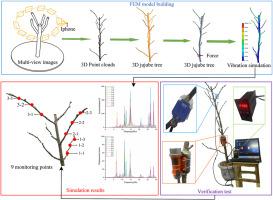Characterising vibration patterns of winter jujube trees to optimise automated fruit harvesting
IF 4.4
1区 农林科学
Q1 AGRICULTURAL ENGINEERING
引用次数: 0
Abstract
Understanding jujube tree dynamic characteristics is crucial for the design and invention of a catch-and-shake machine for fruit harvesting. Currently, the study of vibration characteristics based on the finite element method is the mainstream method for different types of fruit trees. However, limited by the lack of an accurate 3D tree model, there are still gaps between existing simulation analysis and actual tests to explore vibration characteristics. Specifically, the vibration mechanism of winter jujube trees is still unclear in jujube orchards. To address the issue, a multi-view 3D reconstruction technique is employed to acquire precise 3D tree models for simulation analysis. The obtained results from experiments indicate that the determination coefficient R2 of the trunks and branches diameter are 0.96 and 0.91 between reconstructed and actual measurement results. Subsequently, material properties of jujube tree are measured to conduct model analysis and harmonic response analysis to find the optimal frequency range (10–20 Hz) in which a considerable vibration response can be obtained at low vibration energies. Moreover, transient analysis and test experiments are conducted to explore the energy transfer properties under different vibration frequency. Results showed that the acceleration response gradually increased from the bottom to the top of the branch on most branches at non-resonant frequencies. The proposed method can provide informative insights on the design of high-efficiency and low-energy jujube catch-and-shake harvesters.

表征冬枣树的振动模式,优化果实的自动采摘
了解枣树的动态特性对于设计和发明用于果实采收的接果摇摆机至关重要。目前,基于有限元法的振动特性研究是针对不同类型果树的主流方法。然而,受限于缺乏精确的三维果树模型,现有的仿真分析和实际试验在探索振动特性方面仍存在差距。特别是在枣园中,冬枣树的振动机理尚不清楚。针对这一问题,我们采用了多视角三维重建技术来获取精确的三维树木模型,以进行仿真分析。实验结果表明,重建结果与实际测量结果之间树干和树枝直径的判定系数 R2 分别为 0.96 和 0.91。随后,测量了枣树的材料特性,以进行模型分析和谐波响应分析,从而找到最佳频率范围(10-20 Hz),在该频率范围内,可在低振动能量下获得可观的振动响应。此外,还进行了瞬态分析和测试实验,以探索不同振动频率下的能量传递特性。结果表明,在非共振频率下,大多数树枝的加速度响应从树枝底部到顶部逐渐增加。所提出的方法可为设计高效率、低能耗的红枣捕获和摇动收割机提供有益的启示。
本文章由计算机程序翻译,如有差异,请以英文原文为准。
求助全文
约1分钟内获得全文
求助全文
来源期刊

Biosystems Engineering
农林科学-农业工程
CiteScore
10.60
自引率
7.80%
发文量
239
审稿时长
53 days
期刊介绍:
Biosystems Engineering publishes research in engineering and the physical sciences that represent advances in understanding or modelling of the performance of biological systems for sustainable developments in land use and the environment, agriculture and amenity, bioproduction processes and the food chain. The subject matter of the journal reflects the wide range and interdisciplinary nature of research in engineering for biological systems.
 求助内容:
求助内容: 应助结果提醒方式:
应助结果提醒方式:


